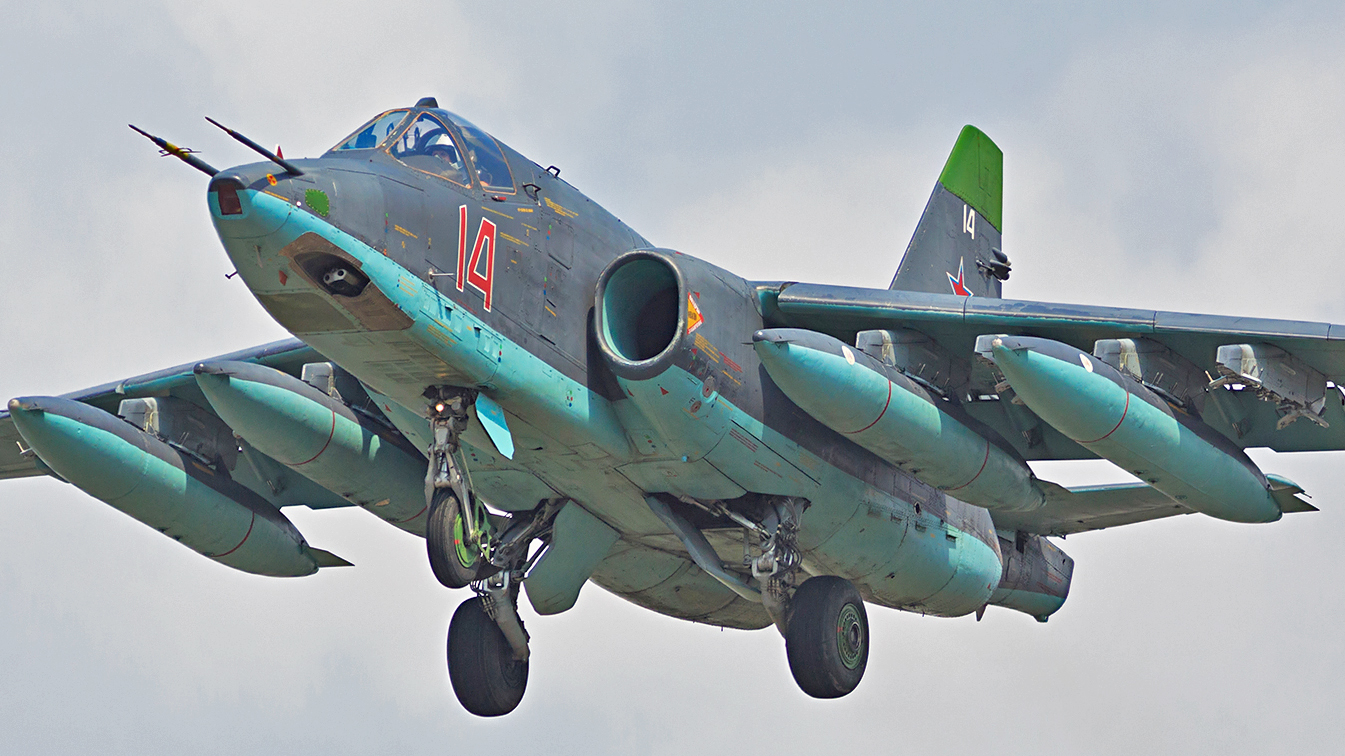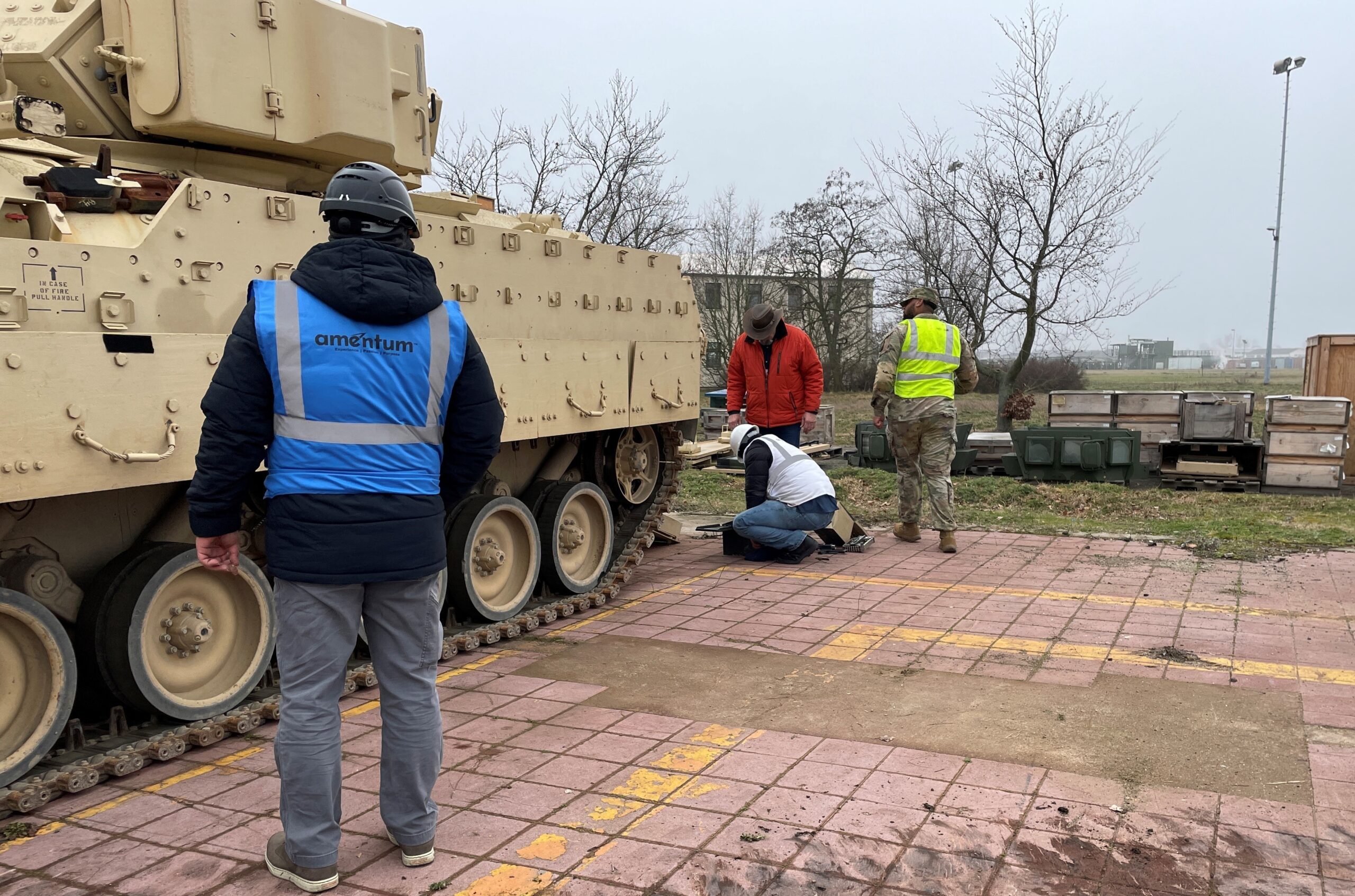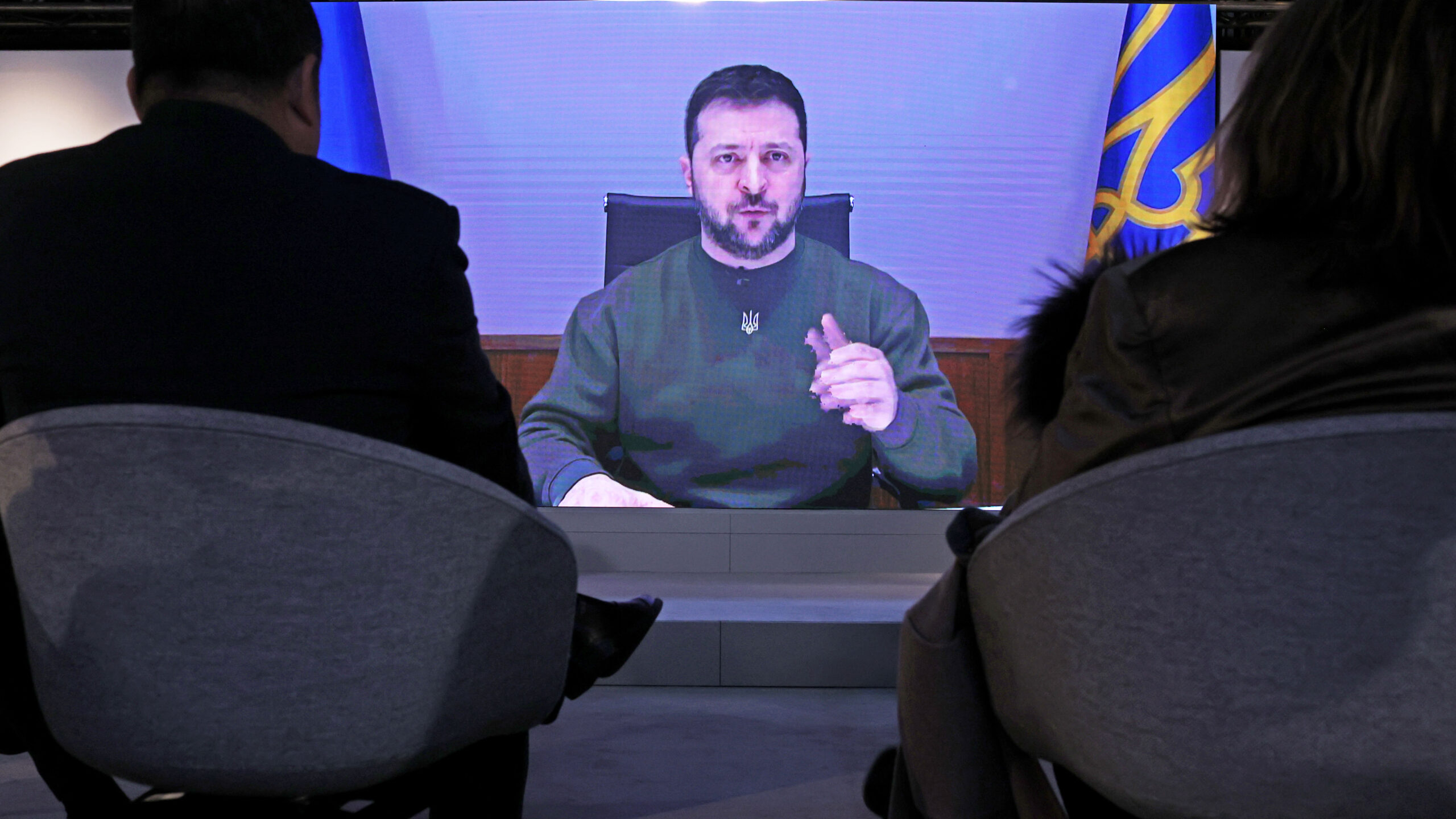Russian President Vladimir Putin will not stop with the invasion of Ukraine, with other former Soviet countries likely to be the next in his sights. That’s the warning from his Ukrainian counterpart Volodymyr Zelensky, who today made the opening address at the Munich Security Conference, at which politicians, military officers, and diplomats from around the world are discussing European defense and diplomacy, unsurprisingly dominated by the war in Ukraine.
“It’s obvious that Ukraine is not going to be [Putin’s] last stop,” Zelensky said. “He’s going to continue his movement all the way … including all the other states that at some point in time were part of the Soviet bloc.”
The three-day conference comes as the war in Ukraine rages on, now on its 359th day, and amid calls to accelerate the delivery of ammunition and other weapons to Kyiv’s forces, with growing fears of the size of Russia’s new offensive. Representing the United States in Munich is Vice President Kamala Harris. Russia is understandably absent from the conference this year.

The previous Munich Security Conference took place just days before the Kremlin launched its invasion of Ukraine, with Western leaders warning Putin against taking such action. The failure of that policy led Zelensky to criticize them for what he considered appeasement toward Moscow.
With that in mind, eyes are very much on the latest installment of the conference, as a means of determining to what degree the West is now willing to stand behind Ukraine militarily in a conflict that is having a significant economic impact, and which is showing no signs of ending any time soon.
Taking to Twitter today, Mykhailo Podolyak, an adviser to President Zelensky, said that “real global security” could only be achieved if Ukraine wins the war.
“Negotiations can begin when Russia withdraws its troops from the territory of Ukraine,” Podolyak wrote. “Other options only give Russia time to regroup forces and resume hostilities at any moment.”
In an interview with the BBC, Zelensky, too, has refused to concede any territory to Russia, claiming that to do so would mean Russia could “keep coming back.” The Ukrainian president also said that he considered the Russian spring offensive was already now underway, stating that “Russian attacks are already happening from several directions.” However, he said that his forces would be able to hold their ground until they can launch a counter-offensive.
Indeed, the fierce nature of the fighting happening right now is made brutally clear in this remarkable video, taken — apparently very recently — by a Ukrainian soldier in a trench. The enemy is so close that this is almost hand-to-hand fighting and, as far as we can see, the one Ukrainian soldier holds off a Russian attack on his position, while one of his comrades takes cover, or waits to emerge.
“If Putin wins in Ukraine, the message to him and other authoritarian regimes is that force is rewarded,” NATO Secretary-General Jens Stoltenberg said this week. “That would make the world more dangerous. And all of us more vulnerable,” Stoltenberg added.
As to which countries could next be under threat from Russian military action, Zelensky highlighted Moldova, which borders Ukraine, and which he said that the Kremlin was looking at ways to “strangle.” Earlier this week, Moldova’s President Maia Sandu accused Russia of plotting to bring down its government, including engaging foreign saboteurs to make this happen. This is the latest in a line of concerns about Moscow’s alleged intentions toward the former Soviet republic.
It recently came to light that Facebook may have played a role in helping foment anti-government feelings in Moldova, by running ads on behalf of exiled Moldovan oligarch Ilan Shor. A pro-Kremlin figure who is on U.S. sanctions lists, Shor’s ads called for protests and uprisings against Moldova’s pro-European Union administration.
So far, NATO defense ministers speaking in Munich have pledged to increase military aid to Kyiv, even while acknowledging that their own dwindling stockpiles of weapons will make this increasingly difficult unless prompt action is taken.
German Minister of Defense Boris Pistorius reiterated his pledge to exceed NATO’s military spending target of 2 percent of GDP, something that Berlin has failed to meet in the past.
“We will make every effort to go beyond it, though this still needs to be agreed within the coalition [government],” Pistorius said. “But it has to be clear to everyone that, with scarcely 2 percent only, we won’t be able to meet the challenges that lie ahead.”
As for Russia, officials there have taken a predictably dim view of the conference in Munich, with Maria Zakharova, spokeswoman for the Russian foreign ministry, accusing the United States of inciting Ukraine to escalate the war by condoning attacks on Crimea. Zakharova warned that the United States was now directly involved in the conflict, driven by “crazy people” who want only to bring Russia to its knees.
The reference to Crimea follows comments from the U.S. Under Secretary of State Victoria Nuland, who called for the demilitarization of Crimea, at a minimum, while stating that the United States supports Ukrainian attacks on military targets on the peninsula.
“[The United States] supply weapons in huge quantities, provide intelligence, simply participate directly in the planning of military operations, train Ukrainian armed formations,” Zakharova said. “Now the American warmongers have gone even further: they are inciting the Kyiv regime to further escalate, simply to transfer the war to the territory of our country.”
You can read more about the latest Ukrainian attacks on Crimea — and the strategic importance of the region — here.
While Western officials meet in Munich today, President Putin was having talks with his Belarusian counterpart, and close ally, Alexander Lukashenko. In a surprising announcement, Lukashenko said that Belarus was ready to start production of the Su-25 Frogfoot ground-attack aircraft, a type utilized heavily by Russia in the war against Ukraine.

Fedor Leukhin/Wikimedia Commons
Noting that Belarus is already producing components for Russian passenger aircraft, Lukashenko said that the country’s three aviation factories could now build Su-25s “with appropriate small technological support from the Russian Federation.”
Provided Russia even wants more of these Cold War-era jets, long out of production, the idea seems highly fanciful, not least because almost all single-seat Su-25s were built in Georgia, not Russia. Two-seat trainer versions were built in Ulan-Ude, Russia, but the production line is long dormant and it’s not even clear if tooling exists that could be transferred to Belarus.
All in all, the episode has some parallels with claims from Belarus and Russia last year that some Belarusian combat aircraft had been modified to carry nuclear weapons and that their pilots were accordingly being trained to fly combat jets equipped with the “special warheads.”
While Lukashenko again appears eager for any opportunity to align himself with Putin, and Russia’s war in Ukraine, President Zelensky, speaking ahead of the Munich Security Conference, said that he considered the likelihood of Belarus actually joining the invasion as low.
Before we head into the latest news from Ukraine, The War Zone readers can get caught up with our previous rolling coverage here.
The Latest
Russia has continued its missile strikes against Ukraine, with a total of 36 air-launched and naval cruise missiles, guided air-to-surface missiles, and anti-ship missiles fired overnight into Thursday, according to Ukrainian officials. The Ukrainian Air Force claims that at least 16 of these missiles were shot down by its air defenses. In particular, these claims account for eight Kalibr naval cruise missiles that were launched from a warship in the Black Sea.
Russian missiles that did reach their targets last night inflicted damage on northern and western Ukraine as well as the central regions of Dnipropetrovsk and Kirovograd. One missile struck an industrial site in the western city of Lviv, leading to a major fire that was eventually brought under control.
The job of Ukraine’s air defenses has been made more difficult of late by changing Russian tactics, officials now admit. Mykhailo Podolyak, an adviser to President Zelenskiy, said yesterday that Russia has “definitely changed tactics” and is using decoy missiles without explosive warheads as well as deploying balloons to spoof air defense radars — this is something that we have looked at in depth in this previous piece.
“They want to overload our anti-aircraft system to get an extra chance to hit infrastructure facilities,” Podolyak told The Associated Press on Thursday.
It seems, however, that the overnight Russian strikes have not had a major impact on Ukraine’s energy infrastructure, at least based on reports from Ukrainian state broadcaster Suspilne. According to this source, the only outages on the energy grid are in Odesa, “due to damaged infrastructure,” with the power supply in other parts of the country otherwise operating without restrictions.
In addition to the latest round of missile strikes, other Ukrainian objectives have come under heavy attack by artillery and rockets in the last 24 hours. Bakhmut, the coal-mining city in Donetsk Oblast that is currently at the heart of the fighting in Donbas, was struck by artillery fire and Grad rockets yesterday, according to Ukraine’s prosecutor general. The projectiles are said to have come down in a residential district of the city, killing three men and two women and wounding nine more.
The status of Ukraine’s hold on Bakhmut is becoming increasingly precarious, at least according to the head of Russia’s Wagner mercenary group. Yevgeny Prigozhin told a Russian military blogger that he expected the city to fall to Russian forces in March or April. Prigozhin did, however, issue a note of warning about the supply of troops and equipment that Wagner is receiving.
“There are a huge number of problems that need to be solved,” Prigozhin said. “Naturally, it will also depend on whether we continue to be bled,” he added, referring to the end of the prisoner recruitment scheme that has been used to boost the ranks of the mercenary group.
According to the latest assessment from the U.K. Ministry of Defense, the convict-recruits deployed by the Wagner Group have probably experienced a casualty rate of up to 50 percent. This is just a part of overall Russian casualties in the conflict, which it now assesses as likely to be in the region of 175,000 to 200,000 since the start of the invasion of Ukraine. Among these, approximately 40,000 to 60,000 are thought likely to have been killed.
Prisoners of war, meanwhile, have also been a topic of recent discussion, with Russia and Ukraine continuing to undertake negotiated exchanges. Andriy Yermak, the head of the Ukrainian president’s office, has confirmed that 100 troops and one civilian have been returned to Ukraine after being captured by Russian forces. Most of these soldiers are said to have been taken during the savage campaign for the southern city of Mariupol, which fell to the Russians in May 2022. In return, Ukraine released 101 prisoners of war who are now back in Russia, according to a statement from the Russian Ministry of Defense, which added:
“Aircraft of the military transport aviation branch of the Russian Aerospace Forces will deliver the released servicemen to Moscow for treatment and rehabilitation in medical institutions of the Russian Ministry of Defense.”
Other important negotiations are set to start soon, this time with a view to continuing the agreement under which Ukraine is able to export grain from Black Sea ports that are otherwise blockaded by Russia. A senior Ukrainian official, Yuriy Vaskov, said he thinks that “common sense will prevail, and the corridor will be extended” during the talks that are scheduled for next week.
The U.S. military has provided a photo update on the progress of the M2A2 Bradley infantry fighting vehicles (IFVs) that are headed to Ukraine, marking a significant increase in firepower and capability for its troops. The following photos were taken at the Coleman Army Prepositioned Stocks-2 worksite in Mannheim, Germany, and show Bradleys being prepared for transfer to Ukraine. More than 60 of the IFVs were shipped from Charleston, South Carolina, to Germany around three weeks ago as part of a $2.85-billion U.S. military aid agreement for Ukraine announced earlier this year.


Yet more advanced equipment is heading to Ukraine in the form of Patriot air defense systems, with Ukrainian personnel now being trained to use these. Tweets from both the Ukrainian Air Force and the German Luftwaffe show Ukrainian troops learning their way around the Patriot in Germany. Following the U.S. lead, the German government decided in January to transfer a single Patriot battery to Ukraine and Ukrainian soldiers have been training at three locations in Germany since January 31.
While we’ve not been able to immediately verify the claims, it’s reported that the first examples of the AMX-10RC heavy armored cars from France are already in Ukraine. The transfer of these was secured at much the same time as the Marder infantry fighting vehicles from Germany and Bradley IFVs from the United States. It’s not yet confirmed exactly what version of the AMX-10RC is being supplied, but these 6×6 armored cars offer an interesting combination of relatively low all-up weight, but heavy armament — in terms of the primary gun system. You can read more about them here.
And, in what is now an increasingly regular feature, today brings another video showcasing the low-flying tactics employed widely in the conflict by both Ukrainian and Russian helicopter and fighter jet crews. In this case, it’s Ukrainian Army Aviation Mi-8 combat transport helicopters that are seen flying along a highway before breaking away, each of them armed with pods for unguided rockets.
That concludes our coverage of the Ukraine conflict for now. We’ll update this story when there’s more news to share.
Contact the author: thomas@thedrive.com
